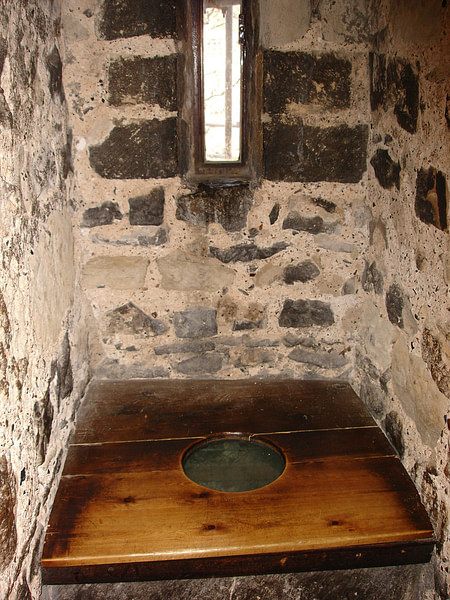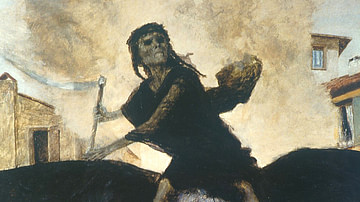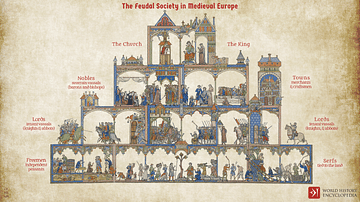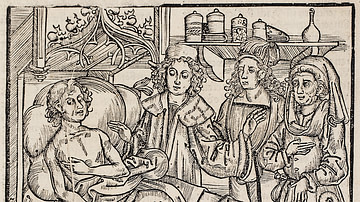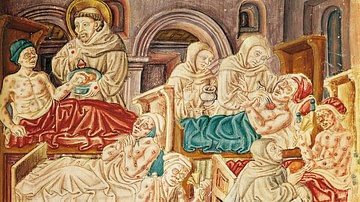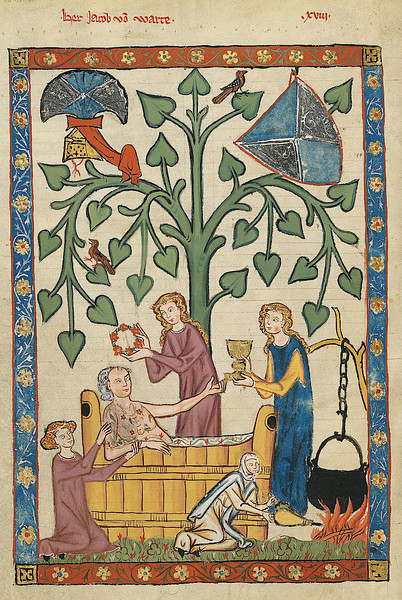
People in the Middle Ages have acquired something of a bad reputation when it comes to cleanliness, especially the peasantry. However, despite the general lack of running water and other modern amenities, there were common expectations of personal hygiene such as regularly washing from a basin, especially the hands before and after eating which was regarded as good etiquette in a period when cutlery was still a rarity for most people. The better off had the possibility of more frequent baths and castles, manors, monasteries, and cities offered their residents better toilets with better drainage, and sometimes even had running water using the ancient combination of cisterns and gravity. Naturally, standards of hygiene varied over time and place, and even, of course, between individuals, just as today; what follows examines the general habits and expectations regarding hygiene in medieval Europe.
Water Supply
Water was available in villages from nearby springs, rivers, lakes, wells and cisterns. Indeed, most settlements had developed where they had precisely because of the proximity of a reliable water source. Castles might be situated for the same reason and were provided with additional water from masonry-lined wells sunk into their interior courtyards, sometimes accessible from within the castle keep for extra security when under attack. Of over 420 castles surveyed in the United Kingdom, 80% were provided with a well in their interiors and one quarter had two or more. The shaft of the well could be extremely deep: the one at Beeston Castle in England measures 124 m. Some castles, such as the one at Rochester in England, even had the possibility to draw up water from the well at every level of the keep using a system of buckets and ropes which ran inside the walls. Cisterns collected rainwater or natural ground seepage and sometimes a castle might have a system of lead, wooden or ceramic pipes which carried water from a cistern to other, lower parts of the castle like the keep or kitchens, as at Chester Castle in England. Another system of supplementary water collection was to have pipes on the roofing to drain rainwater into a cistern. Finally, settling tanks were sometimes employed to improve the quality of the water by allowing sediment to settle before the cleaner water was drained off. Many monasteries would also have had some or all of these features.
As towns grew in number and size across Europe from the 11th century CE onwards so hygiene became more and more of a daily challenge. Fortunately, many of the larger towns tended to be situated near rivers or coastlines in order to facilitate trade, so the supply of water and the disposal of waste was less problematic in these places. Canals, water conduits, wells and fountains provided (relatively) fresh water to the urban populace. These were maintained by town councils who also imposed sanitary measures on local businesses and the population in general. For example, there was often an obligation to clean the portion of the street directly in front of one's house or shop. Towns and cities might have public baths; Nuremberg, which seems to have been one of the cleanest towns in Europe thanks to its enlightened council, had 14 of them. Local authorities also undertook such emergency measures as removing the dead during times of plague.
Personal Hygiene
As running water was very rare, and considering it took such a physical effort to get one bucketful from a well or nearby water source, it is perhaps not surprising that taking a full bath every day was not a feasible option for most people. Indeed, with baths seen as a luxury given the cost of fuel to heat the water, monks, for example, were typically prohibited from taking more than two or three baths in a year. For those who had a bath, it most often took the form of a wooden half-barrel or tub. Even then it would not have been filled very much but most of the 'bathing' was done using a jug of heated water poured over the body rather than a full immersion. A lord might have a padded bath for extra comfort and he usually travelled with one, such was the uncertainty of finding the convenience on one's travels. The vast majority of people, though, would have made do with a quick swill using a basin of cold water. As 80% of the population did physically demanding jobs working the land it is likely that washing of some kind was done on a daily basis.
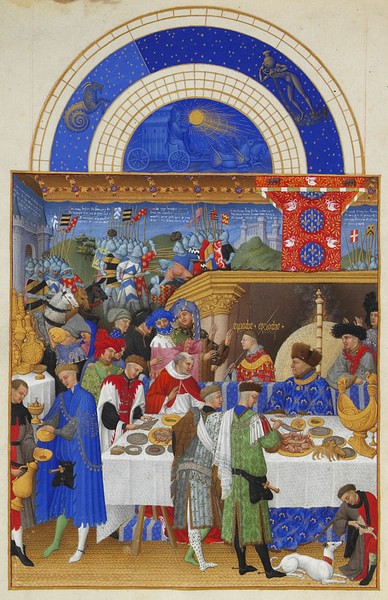
Medieval peasants have long been the butt of jokes regarding hygiene, which goes back to medieval clerical tracts which often described them as little more than brutish animals; however, it was common practice for just about everyone to wash the hands and face in the morning. An early wash was also desirable because fleas and lice were a common problem. Rarely-changed straw bedding was a particular paradise for vermin even if some preventative measures were taken such as mixing herbs and flowers like basil, chamomile, lavender and mint into the straw.
As most people ate meals without knives, forks or spoons, it was also a common convention to wash hands before and after eating. Soap was sometimes used and hair was washed using an alkaline solution such as the one obtained from mixing lime and salt. Teeth were cleaned using twigs (especially hazel) and small pieces of wool cloth. Shaving was either not done at all or once a week unless one was a monk, in which case one was shaved daily by a brother. As medieval mirrors were still not very large or clear, it was easier for most people to visit the local barber when required.
The ordinary peasant was probably more concerned with getting rid of the day's grime when they washed but for an aristocrat there were a few more details to be attended to in order to gain favour in polite society. Social occasions like meals, when one might get up close and personal to one's peers, warranted particular attention to hygiene and there were even rules of etiquette produced as helpful guides for the unimaginative diner, as here from the Les Countenance de Table:
…and let your fingers be clean, and your fingernails well-groomed.
Once a morsel has been touched, let it not be returned to the plate.
Do not touch your ears or nose with your bare hands.
Do not clean your teeth with a sharp iron while eating.
It is ordered by regulation that you should not put a dish to your mouth.
He who wishes to drink must first finish what is in his mouth.
And let his lips be wiped first.
Once the table is cleared, wash your hands, and have a drink.
(Singman, 154)
Monks had their own special areas for washing, including at Cluny Abbey in France which had a lavabo or large basin where hands were washed before meals. We know from records that they had towels, which were changed twice a week while the water was changed only once a week. The Great Hall of a castle or manor typically had a similar large basin for visitors to wash their hands.
In summary, then, it is safe to say that the common presentation in modern films and books of filthy medieval peasants who regarded washing as some form of torture is perhaps not quite accurate and people of all classes did keep themselves as clean as their circumstances permitted. Nevertheless, it is also true that when medieval Europeans, even those of the higher classes, made contact with other cultures such as the Byzantines or the Muslims during the Crusades, the Europeans often came off second best in the hygiene stakes.
Toilets
In villages or on manor estates the peasantry used a cesspit for their own waste, which might then be taken and spread on the fields as a fertiliser. In some cases a small hut provided some privacy and a wooden bench with a hole in it some comfort (as well as reducing the chances of falling into the cesspit). Chamber pots were used at night and then emptied into the cesspit. Without toilet paper, or really paper of any kind, people had to make do with a handful of hay, grass, straw or moss.
The toilets in a castle, also known as privies or latrines, were much the same as everywhere else although the waste was channelled down a hole into a cesspit at the foot of the castle walls or into the moat itself (an added defensive feature not much talked about in military history). Sometimes there were two toilets next to each other and these might empty into a channel which was regularly flushed with water from a diverted stream. The same arrangement was common to monasteries where toilets were clustered together. There were 45 such cubicles at Cluny Abbey which also boasted a bathhouse with twelve tubs. Castles might also have triangular-shaped urinals, especially in the tower of the circuit walls.
In towns, the well-off had their own privy in a back-yard or even in the house itself with a channel or chute to drain off waste into the yard. Where the poorer classes lived in greater concentrations households often shared a single outside toilet or a number of toilets with their waste leading to a communal cesspit. Lined with stone, the cesspits also received any other household rubbish and were regularly emptied by a professional labourer dedicated to that specific and unenviable job. There were regulations prohibiting the tipping of waste into the street but these were often ignored and a spell of heavy rain or, even worse, floods, could cause havoc with the town's sanitation system and contaminate the water supply. With towns also packed with horses and donkeys, and farm animals being transported elsewhere or to the butchers, the streets were usually filthy and this combined with the ever-present rats, mice and other vermin meant that urban centres became the ideal breeding grounds for disease.
Plague & Diseases
The Black Death, which peaked from 1347 to 1352 CE, was just one (albeit the deadliest) of many waves of plagues and diseases which hit medieval Europe. Carried by fleas on rats, the bubonic plague killed anywhere between 30% and 50% of the population wherever it took hold. The low standards of medieval hygiene certainly helped it along although there were other factors such as a complete lack of understanding of what caused it and the absence of effective quarantines. It is also important to note that many medieval locations such as Milan and Bohemia survived relatively unscathed, so it is not quite so simple to attribute the spread of plague solely to a lack of hygiene and proper sanitation.
Besides terrible plagues and epidemics that seemed to spring out of nowhere with alarming regularity, there were often equally deadly dangers lurking in everyday places. Poor food preparation and storage was a particular area of health risk. Epidemics of diarrhoea (ergotism), known in medieval times as Saint Anthony's Fire, were caused by eating rye that had been poisoned by fungi. Skin diseases were particularly prevalent, too, although they may have been caused just as much by poor diet as by uncleanliness.
